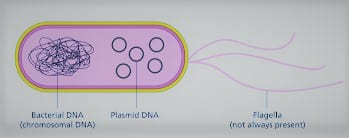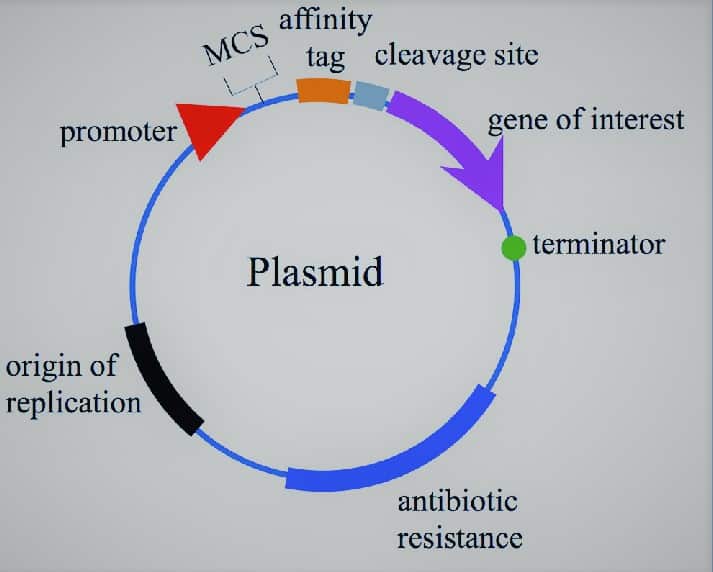Table of Contents
TogglePlasmids are smaller circular segments of DNA molecules, present in the cytoplasm of bacteria, archaea, and some microorganisms. Plasmids undergo self-replication and are entirely different from the chromosomal DNA of their host organism. Plasmids, also called extra chromosomal DNA have a small number of genes that consult with resistance to toxin and antibiotic environments. Chromosomal DNA has a large number of genes, which are responsible to transform genetic information in organisms, by transcription and translation.
Plasmid Definition
The artificial plasmid is used as a vector in the gene transfer process and modified DNA is easily introduced in a host cell. Plasmid possesses stretch of DNA for self-replication phenomena progressing. Isolation of plasmid DNA is crucial in different fields of research and scientific study like biotechnology, genetic engineering, molecular biology, and synthetic biology.


Classification of Plasmids
Plasmids may classify into various ways, broadly classified into:
- Conjugative and non-conjugative plasmid
- Conjugative plasmids: Having the sets of transfer genes, that are responsible for enhancing intercellular sexual conjugation. In the conjugation process transfer of plasmids from one cell to another cell with the assist of a smaller hair sack i.e. called sex pili. Conjugated plasmids have a size of 20-200 kb.
- Non-Conjugated plasmids: Plasmids which are enabled to commence the conjugation, are said to be Non-Conjugate plasmids. The transfer of Non-conjugate plasmid assists by conjugate plasmid; parasitize a conjugate plasmid.
- Incompatibility group Classification of plasmid: A bacterial cell enables to maintain of two different forms of plasmid within the single cell is called plasmid incompatibility, which is a virtue of having the same replicon for multiple plasmids.
- Classification on the basis of functions
- Fertility plasmids
- Resistance plasmids
- Col plasmids
- Degradative plasmids, to digest unusual substances e.g toluene
- Virulence plasmids convert bacteria into pathogens. e.g. Ti plasmid
Isolation of Plasmid DNA by alkaline lysis method
As we already discussed about isolation of genomic DNA in our previous content, now we are going to study about isolation of Plasmid DNA:
Chemical required
- Bacteria culture containing plasmid DNA
- lysis buffer
- neutralizing buffer
- isopropanol
- 70% ethanol
- TE buffer
- From the bacterial culture containing plasmid DNA, about 1-5 mL of culture is taken in test tube.
- The pellets is centrifuged at room temperature at 4000 RPM for about 5 minutes.
- The superntant is discarded and the pellets is taken.
- And the pellets is resuspend in 250 microlitre lysis buffer
- Then 250 microlitre of alkaline lysis buffer is added and tube is gently mixed . (Vertex is not allowed at this time)
- The mixture is incubated for 5-10 minutes
- Now 350 microlitre of potassium acetate is added and is gently mixed.
- The mixture is centrifuged at 12000 rpm for 10 minutes and the plasmid is seen in supernatant.
- The supernatant is transfer to new tube and equal amount of isopropanol is added and is mixed.
- The mixture is again centrifuged at 12000 and the plasmid is seen as white ppt.
- The supernatant is discarded and pellet is washed with 70 % ethanol and ethanol is removed.
- The pellets is dried completely and TE buffer is added and gel electrophoresis will be run.
Application of plasmid DNA
Plasmid DNA has wide applications in different research and medicinal field some important applications are discussed below:
- Cloning: Simply, cloning is a technique of development of genetically identical mimetic of organisms. In cloning, the plasmid is used as a vector; the presence of the site for insertion of the antisense sequence of the guest. Plasmids have replicon and transfer the inserted genes to the host cell.
- Protein Production: In general plasmids produce proteins of its concern. However large no of inserted proteins have been synthesized from the inserted plasmids; the main interest in pharmacogenomics
- Gene therapy: As discussed earlier, plasmids are key vectors in gene transfer; used in gene therapy for the synthesis of antisense of particular genes, and application of base pairing of DNA.
- Recombinant DNA technology: A set of techniques of transfer genetic material from one organism to another. Plasmid DNA is used to produce and development of transgenic plants.
- Isolation of plasmid: It is not easy to isolation of plasmids from the bacterial cell; chromosomal DNA also extract along with it. The plasmid DNA isolation is undertaken in a specific pH solution. Plasmids are quite resistant to permanent denaturation at a certain PH range plasmid remain stable but chromosomal DNA get denature easily.
- Alkaline lysis principle: Alkaline lysis is the chemical method, in which the bacterial cells lysed by EDTA and SDS (Sodium Dodecyl Sulfate) detergent which inactivates and weakens the bacterial cell. The SDS weeps out lipid molecules. The addition of NaOH raises the PH of 11-12, at this pH both chromosomal DNA and plasmids. The solution, PH subsides by adding sodium and potassium acetate, and renaturation of plasmids take place. The precipitate expels out by centrifugation, further purification of plasmids by organic extraction or adsorption to a resin.
Differences between plasmid and chromosomal DNA
| Plasmid DNA | Chromosomal DNA |
| Smaller size, circular in shape present in cytoplasm of the cell. | Smaller size, circular in shape present in the cytoplasm of the cell. |
| Present only in the prokaryotic cells. | Present in both prokaryotic and eukaryotic cells |
| Transfer during horizontal conjugation. | Transfer during cell division |
| Plasmid DNA has replicons, so, it undergoes replication. | Plasmid DNA has replicons, so, it undergoes replication. |
| Plasmid does not take part in reproduction and proper cell functioning. | Does not responsible for the transform of genetic material |
| Chromosomal DNA plays a key role in, reproduction and proper cell functioning. | Chromosomal DNA play a key role in, reproduction and proper cell functioning. |
FAQs/MCQs
What do you mean by RNA plasmid?
Plasmids have linear RNA replicons and are non-infectious, present in diverse species of fungi and plants. They can be encapsidated or unencapsulated.






